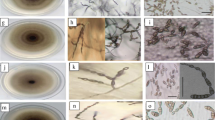Abstract
The morphological and molecular characterization using primers EryF and EryR confirmed the associated pathogen with collected samples of tomato powdery mildew as Oidium neolycopersici. Incubation and latent period of the pathogen under in vitro was 4 and 5 days, respectively, however it was 5 days for both under in vivo. Effect of weather variables on the disease development in March 30th and August 30th transplanted crop showed that low temperature and high relative humidity were most favourable factors for disease development. The studies on colonization behavior of the pathogen showed that tissue colonization was directly proportional to the disease severity.



Similar content being viewed by others
References
Anonymous (2015) Indian Horticulture Database. 2015. National Horticulture Board. Ministry of Agriculture and Farmers Welfare, Government of India. http://nhb.gov.in. Accessed June 2016
Attanayake RN, Glawe DA, Dugan FM, Chen W (2009) Erysiphe trifolii causing powdery mildew of lentil (Lens culinaris). Plant Dis 93:797–803. https://doi.org/10.1094/PDIS-93-8-0797
Baiswar P, Braun U, Chandra S, Ngachan SV (2009) First report of an Oidium sp. [neolycopersici] on Solanum betaceum in India. Australas Plant Dis Notes 4:32–33
Banyal DK, Chaudhary J, Singh A (2015) Evaluation of pea (Pisum sativum) germplasm for inheritance of resistance to powdery mildew (Erysiphe pisi). Indian Phytopathol 68(2):166–171
Boiteux LS (1994) Powdery mildew of potato caused by Erysiphe cichoracearum in Brazil. Plant Dis 78:830. https://doi.org/10.1094/PD-78-0830B
Burgerjon A, Nicot PC, Bertrand F, Blancard D (1990) Early powdery mildew of greenhouse-grown tomatoes in France. (Abstr.). J Phytopathol 80:1063
Campbell RN, Scheuerman RW (1979) Oidiopsis taurica on processing tomatoes in the central valley of California. Plant Dis Rep 63:1087
Cerkauskas R (2005) The world vegetable fact sheet; Tomato Diseases Powdery Mildew. The World Vegetable Center, Shanhua
Cerkauskas RF, Ferguson G, Banik M (2011) Powdery mildew (Leveillula taurica) on greenhouse and field peppers in Ontario-host range, cultivar response and disease management strategies. Can J Plant Pathol 33:485–498
Correll JC, Gordon TR, Elliot VJ (1987) Host range, specificity and biometrical measurements of Leveillula taurica in California. Plant Dis 71:248–251
Correll JC, Villarroel MI, McLeod PJ, Cazon MI, Rivadeneria C (2005) First report of powdery mildew caused by Leveillula taurica on tomato and pepper in Bolivia. Plant Dis 89:776
Gupta SK, Gupta A, Shyam KR, Bhardwaj R (2001) Morphological characterization and effect of meteorological factors on development of cucumber powdery mildew. Indian Phytopathol 54(3):311–315
Ivic D, Milicevic T, Cvjetkovic B (2008) First Croatian report of powdery mildew on tomato caused by Oidium neolycopersici. New Dis Rep 18:35
Jacob D, David DR, Elad Y (2007) Biology and biological control of tomato powdery mildew (Oidium neolycopersici). Bull OILB/SROP 30:329–332
Jones H, Whipps JM, Gurr SJ (2001) Tomato powdery mildew fungus Oidium neolycopersici. Mol Plant Pathol 2:303–309
Kiss L, Cook RTA, Saenz GS, Cunnington JH, Takamatsu S, Pascoe I, Bardin M, Nicot PC, Sato Y, Rossman AY (2001) Identification of two powdery mildew, Oidium neolycopersici and Oidium lycopersici, infecting tomato in different parts of the world. Mycol Res 105:684–697
Kiss L, Takamatsu S, Cunnington JH (2005) Molecular identification of Oidium neolycopersici as the causal agent of the recent tomato powdery mildew epidemics in North America. Plant Dis 89:491–496. https://doi.org/10.1094/PD-89-0491
Koike ST, Saenz GS (1999) Powdery mildew of spearmint caused by Erysiphe orontii in California. Plant Dis 8:399
Kontaxis DG, Van MA (1978) Powdery mildew of tomato—a new disease in the United States. Plant Dis Rep 62:892–893
Li CW, Pei DL, Wang WJ, Ma YS, Wang L, Wang F, Liu JL, Zhu WM (2008) First report of powdery mildew caused by Oidium neolycopersici on tomato in China. Plant Dis 92:1370. https://doi.org/10.1094/PDIS-92-9-1370C
Marois JJ, Momol MT, Kimbrough JW, Hochmuth RC, Dankers W (2001) First report of powdery mildew on greenhouse tomatoes caused by Oidium neolycopersici in Florida. Plant Dis 85:1292
Mieslerova B, Lebeda A (2010) Influence of temperature and light conditions on germination, growth and conidiation of Oidium neolycopersici. J Phytopathol 158:616–627. https://doi.org/10.1111/j.1439-0434.2009.01663
Montilla JO, Gonzalez MS, Renaud D (2007) First report of powdery mildew on tomato caused by Oidium neolycopersici in Venezuela. Plant Dis 91:910
Murray HG, Thompson WF (1980) Rapid isolation of high molecular weight plant DNA. Nucleic Acids Res 8:4321–4325
Neupane AC, Subedi RC (2010) Tomato powdery mildew (Pseudoidium neolycopersici). http://www.plantwise.org. Accessed June 2016
Serawit Y, Fanos T (2016) Review on distribution, biology and management of tomato powdery mildew (O. neolycopersici). J Biol Agric Healthc 6(3):109–116
Shankar R, Harsha S, Bhandary R (2014) A practical guide to identification and control of tomato diseases. P 24 TROPICA SEEDS PVT LTD|No 54, South End Road, 1st Floor, Nama Aurore Building, Basavangudi, Bangalore 560004, India
Sheng Z, Yu CU, Hua Y, Jun SX, Wei H, Feng JJ, Rong SC, Wei C (2011) Occurrence of powdery mildew of autumn delayed tomato cultivated in facilities soilless matrix and test of its pesticide control. Xinjiang Agric Sci 48:369–373
Stevanovic M, Stankovic I, Vucurovic A, Dolovac N, Pfaf-Dolovac E, Krstic B, Bulajic A (2012) First report of Oidium neolycopersici on greenhouse tomatoes in Serbia. Plant Dis 96:912
Tamura K, Stecher G, Peterson D, Filipski A, Kumar S (2013) MEGA6: molecular evolutionary genetics analysis version 6.0. Mol Biol Evol 30:2725–2729. https://doi.org/10.1093/molbev/mst197
Yolageldi L, Sin B, Onogur E (2008) First report of Oidium neolycopersici on tomatoes in Turkey. Plant Pathol 57:373
Author information
Authors and Affiliations
Corresponding author
Rights and permissions
About this article
Cite this article
Rana, A., Malannavar, A.B. & Banyal, D.K. Studies on biology and environmental factors affecting the development of tomato powdery mildew under protected cultivation. Indian Phytopathology 71, 385–391 (2018). https://doi.org/10.1007/s42360-018-0049-4
Received:
Revised:
Accepted:
Published:
Issue Date:
DOI: https://doi.org/10.1007/s42360-018-0049-4



